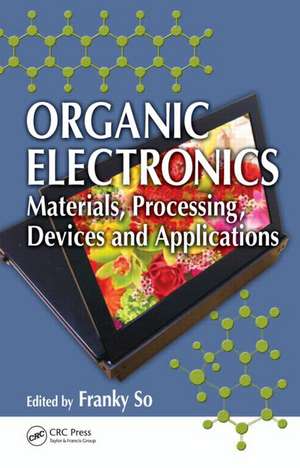Organic Electronics: Materials, Processing, Devices and Applications
Editat de Franky Soen Limba Engleză Hardback – 24 noi 2009
Considering the rapid development in this field, Organic Electronics: Materials, Processing, Devices and Applications is a long-overdue assessment of state-of-the-art technology in organic electronics. This valuable reference harnesses the insight of various experts in the field, who contribute entire chapters on their area of specialty, covering chemistry and materials, fundamental physics, device processing, fabrication, and applications.
Coverage includes cutting-edge advances in:
- Organic vapor phase deposition to fabricate organic nanostructures
- Organic semiconductor device physics
- Organic thin film and vertical transistors
- Organic photovoltaic cells
- OLED technologies for flat panel displays and lighting
Preț: 1343.56 lei
Preț vechi: 1638.48 lei
-18% Nou
Puncte Express: 2015
Preț estimativ în valută:
257.17€ • 279.44$ • 216.16£
257.17€ • 279.44$ • 216.16£
Carte tipărită la comandă
Livrare economică 21 aprilie-05 mai
Preluare comenzi: 021 569.72.76
Specificații
ISBN-13: 9781420072907
ISBN-10: 1420072900
Pagini: 582
Ilustrații: 356 b/w images, 24 tables and 100-200 equations
Dimensiuni: 156 x 234 x 33 mm
Greutate: 0.93 kg
Ediția:1
Editura: CRC Press
Colecția CRC Press
ISBN-10: 1420072900
Pagini: 582
Ilustrații: 356 b/w images, 24 tables and 100-200 equations
Dimensiuni: 156 x 234 x 33 mm
Greutate: 0.93 kg
Ediția:1
Editura: CRC Press
Colecția CRC Press
Public țintă
ProfessionalCuprins
Part I: Materials and Processing
p-Conjugated Polymers for OLEDs. Organic Vapor-Phase Deposition.
Part II: Device Physics
Charge Transport and Injection in Amorphous Organic Semiconductors. Magnetic Field Effects in Organic Semiconducting Materials and Devices. Interface in Organic Semiconductor Devices: Dipole, Doping, Band Bending, and Growth. Interfaces in Organic Electronic Devices—New Insights to Traditional Concepts. The Role of Homolytic Reactions in the Intrinsic Degradation of OLEDs. Materials and Interface Engineering in Organic Light-Emitting Diodes.
Part III: Organic Electronic Devices
Microcavity Effects in Organic Light-Emitting Devices. Vertical-Type Organic Transistors. Routes toward High-Efficiency Polymer Solar Cells. Mixed Molecular Heterojunction Photovoltaic Cells.Development of Polymer Semiconductors for Field-Effect Transistor Devices in Displays.
Part IV: Applications
OLED Materials and Device Architectures for Full-Color Displays and Solid-State Lighting. Organic Light-Emitting Diodes and Photodetectors for Optical Communication.
Part I: Materials and Processing
p-Conjugated Polymers for OLEDs. Organic Vapor-Phase Deposition.
Part II: Device Physics
Charge Transport and Injection in Amorphous Organic Semiconductors. Magnetic Field Effects in Organic Semiconducting Materials and Devices. Interface in Organic Semiconductor Devices: Dipole, Doping, Band Bending, and Growth. Interfaces in Organic Electronic Devices—New Insights to Traditional Concepts. The Role of Homolytic Reactions in the Intrinsic Degradation of OLEDs. Materials and Interface Engineering in Organic Light-Emitting Diodes.
Part III: Organic Electronic Devices
Microcavity Effects in Organic Light-Emitting Devices. Vertical-Type Organic Transistors. Routes toward High-Efficiency Polymer Solar Cells. Mixed Molecular Heterojunction Photovoltaic Cells.Development of Polymer Semiconductors for Field-Effect Transistor Devices in Displays.
Part IV: Applications
OLED Materials and Device Architectures for Full-Color Displays and Solid-State Lighting. Organic Light-Emitting Diodes and Photodetectors for Optical Communication.
p-Conjugated Polymers for OLEDs. Organic Vapor-Phase Deposition.
Part II: Device Physics
Charge Transport and Injection in Amorphous Organic Semiconductors. Magnetic Field Effects in Organic Semiconducting Materials and Devices. Interface in Organic Semiconductor Devices: Dipole, Doping, Band Bending, and Growth. Interfaces in Organic Electronic Devices—New Insights to Traditional Concepts. The Role of Homolytic Reactions in the Intrinsic Degradation of OLEDs. Materials and Interface Engineering in Organic Light-Emitting Diodes.
Part III: Organic Electronic Devices
Microcavity Effects in Organic Light-Emitting Devices. Vertical-Type Organic Transistors. Routes toward High-Efficiency Polymer Solar Cells. Mixed Molecular Heterojunction Photovoltaic Cells.Development of Polymer Semiconductors for Field-Effect Transistor Devices in Displays.
Part IV: Applications
OLED Materials and Device Architectures for Full-Color Displays and Solid-State Lighting. Organic Light-Emitting Diodes and Photodetectors for Optical Communication.
Part I: Materials and Processing
p-Conjugated Polymers for OLEDs. Organic Vapor-Phase Deposition.
Part II: Device Physics
Charge Transport and Injection in Amorphous Organic Semiconductors. Magnetic Field Effects in Organic Semiconducting Materials and Devices. Interface in Organic Semiconductor Devices: Dipole, Doping, Band Bending, and Growth. Interfaces in Organic Electronic Devices—New Insights to Traditional Concepts. The Role of Homolytic Reactions in the Intrinsic Degradation of OLEDs. Materials and Interface Engineering in Organic Light-Emitting Diodes.
Part III: Organic Electronic Devices
Microcavity Effects in Organic Light-Emitting Devices. Vertical-Type Organic Transistors. Routes toward High-Efficiency Polymer Solar Cells. Mixed Molecular Heterojunction Photovoltaic Cells.Development of Polymer Semiconductors for Field-Effect Transistor Devices in Displays.
Part IV: Applications
OLED Materials and Device Architectures for Full-Color Displays and Solid-State Lighting. Organic Light-Emitting Diodes and Photodetectors for Optical Communication.
Notă biografică
Franky So received his BA in physics from Hamilton College, his MS in materials science from the Massachusetts Institute of Technology, and his Ph.D in electrical engineering from the University of Southern California. After his graduation in 1991, he worked as a research scientist at the Hoechst Celanese Research Division studying high-speed polymer electro-optical modulators and organic light-emitting diodes (OLEDs). In 1993, he joined the Motorola Phoenix Corporate Laboratories working on OLEDs for flat-panel displays. He later became the program manager responsible for the development of OLED technology. During his tenure at Motorola, he received the Distinguished Innovator Award and the Master Innovator Award. In 2001, So joined OSRAM Opto-Semiconductors and became the head of materials and devices research. He was responsible for managing the OLED R&D activities for flat-panel displays as well as solid state lighting. In the summer of 2005, he joined the faculty in the Department of Materials Science and Engineering at the University of Florida. He currently works as an associate professor in the department. His research interests include electronic properties of organic semiconductor thin films, charge transport properties, device physics, organic-based light-emitting devices, organic photovoltaics, and organic sensors. Dr. So is currently an associate editor of the IEEE Journal of Display Technology and the journal Materials Science and Engineering Reports. Dr. So has more than 70 publications, holds more than 60 patents and is a Fellow of SPIE.
Descriere
Although organic electronics has received increased attention in scientific journals, most books on the subject only cover certain aspects of organic electronic materials and devices. This book is perhaps the first to detail the chemistry, physics, and processing involved—as well as different types of applications. Leading experts focus on their area of specialty to cover chemistry and materials, fundamental physics, device processing, fabrication, and subsequent applications. Describing the state of the art, this book presents experienced researchers with information on the latest developments while also providing an overview for those new to the field.













